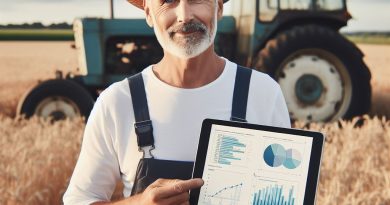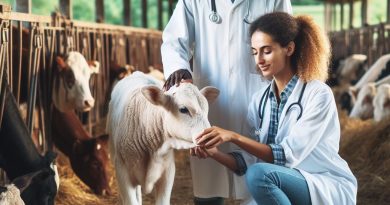Self-Driving Tractors: Farming Made Easy
Last Updated on March 2, 2024
Introduction to self-driving tractors
Self-driving tractors have revolutionized farming by utilizing autonomous technology to perform various tasks efficiently and effortlessly.
Definition and Explanation of Self-Driving Technology in Tractors
Self-driving technology in tractors refers to the capability of these machines to operate without human intervention, utilizing sensors, cameras, and GPS technology.
It enables them to navigate, analyze data, and execute farming tasks accurately.
Brief History of the Development of Self-Driving Tractors
The development of self-driving tractors can be traced back to the early 1990s when the agricultural industry recognized the need for automation.
Companies started experimenting with GPS and autopilot systems to enhance tractor capabilities.
However, it was in the early 2000s when significant progress was made with the advent of advanced sensors and computer vision technology.
These advancements allowed tractors to perceive their surroundings, making them more efficient and precise in performing tasks.
Over the years, self-driving tractors have continued to evolve, incorporating artificial intelligence and machine learning algorithms, enabling them to make independent decisions and adapt to different farming conditions effectively.
Today, self-driving tractors are equipped with advanced software and hardware, including GPS navigation systems, sensors, and cameras. They can accurately navigate fields, analyze soil conditions, and execute tasks such as plowing, planting, and harvesting.
The integration of self-driving tractors in agriculture has not only reduced the physical strain on farmers but also increased productivity and efficiency.
With automation, farmers can save time and resources, resulting in better crop yields and improved agricultural practices.
In essence, self-driving tractors have simplified farming operations, offering remarkable advantages in terms of precision, productivity, and sustainability.
The continuous advancements in autonomous technology will undoubtedly reshape the future of agriculture.
Benefits of self-driving tractors in farming
Self-driving tractors have revolutionized the farming industry, offering a multitude of benefits to farmers worldwide.
Increased Productivity and Efficiency
- Self-driving tractors eliminate the need for human operation, allowing them to work around the clock.
- They can cover larger areas in a shorter amount of time, increasing overall productivity.
- These tractors are equipped with advanced technologies, enabling them to optimize their performance and work with precision.
Reduction in Labor Costs and Dependency
- Farmers can reduce their labor costs significantly as self-driving tractors require minimal human intervention.
- These tractors can perform tasks that would otherwise require multiple farm workers.
- By reducing dependency on human labor, farmers can overcome the challenges of labor shortages in rural areas.
Improved Accuracy and Precision in Field Operations
- Self-driving tractors are equipped with advanced GPS systems and sensors, ensuring accurate navigation and positioning.
- They can precisely sow seeds, apply fertilizers, and spray pesticides, leading to optimized plant growth.
- These tractors can also adjust their operations based on real-time data, ensuring that tasks are performed precisely.
Enhanced Safety and Reduced Accidents
- With self-driving tractors, the risk of accidents caused by human error or fatigue is significantly reduced.
- These tractors are equipped with advanced obstacle detection systems, preventing collisions with objects or people.
- Farmers can remotely monitor and control these tractors, ensuring safer operations from a distance.
Conservation of Natural Resources and Environmental Benefits
- Self-driving tractors can optimize the usage of water, fertilizers, and pesticides by applying them precisely where needed.
- This intelligent application reduces wastage and helps conserve natural resources.
- By minimizing chemical usage, self-driving tractors contribute to a healthier environment and reduce pollution.
In short, self-driving tractors bring numerous advantages to the farming industry, including increased productivity, reduced labor costs, improved accuracy, enhanced safety, and environmental benefits.
Embracing this technology can lead to a more efficient, sustainable, and profitable future for farmers worldwide.
Read: Hydroponics: High-Tech Farming Simplified
Features and Technology Behind Self-Driving Tractors
Self-driving tractors have revolutionized the farming industry by incorporating advanced features and cutting-edge technology.
Let’s explore the technologies that make these tractors stand out:
GPS and Navigation Systems
Self-driving tractors rely on GPS and navigation systems to determine their precise location and navigate across the fields.
These systems use satellites to provide accurate positioning information.
The GPS technology enables the tractors to follow pre-determined routes, ensuring precise planting, fertilizing, and harvesting techniques.
Farmers can also create virtual boundaries for the tractors, ensuring they stay within the designated areas.
Autonomous Control and Steering Mechanisms
One of the key features of self-driving tractors is their autonomous control and steering mechanisms.
These tractors can operate without human intervention, enhancing efficiency and reducing labor requirements.
The autonomous control system takes into account various factors such as field terrain, obstacles, and crop conditions to make intelligent decisions.
It ensures the tractor follows the most efficient path while avoiding collisions or damage to plants.
Sensors and Cameras for Obstacle Detection
Self-driving tractors are equipped with sensors and cameras that play a fundamental role in obstacle detection and navigation.
These devices continuously gather data about the surrounding environment.
Sensors detect obstacles such as rocks, trees, or uneven terrain, allowing the tractor to adjust its route accordingly.
Cameras provide real-time visual feedback, enabling the tractor to navigate even in low-light conditions.
Artificial Intelligence and Machine Learning Algorithms
Artificial intelligence (AI) and machine learning algorithms power the decision-making capabilities of self-driving tractors.
These technologies enable the tractors to learn from past experiences and improve their performance over time.
The tractors analyze massive amounts of data collected from sensors, cameras, and historical farming data.
This information helps them make informed decisions regarding crop management, planting density, and optimal harvesting times.
Integration with Other Smart Farming Technologies
Self-driving tractors can be seamlessly integrated with other smart farming technologies, allowing for a comprehensive and interconnected agricultural system.
For instance, these tractors can connect with crop monitoring systems to gather real-time data on soil moisture levels or nutrient requirements.
They can also collaborate with drones for aerial imaging and crop analysis.
In summary, self-driving tractors incorporate features such as GPS and navigation systems, autonomous control, obstacle detection sensors, AI algorithms, and integration with other smart farming technologies.
These technologies streamline farming processes, maximize productivity, and pave the way for a more sustainable and efficient agricultural future.
Read: Climate Smart Agriculture: Tech Solutions

Examples of self-driving tractors in the market
In today’s modern world, technology is revolutionizing various industries, including agriculture.
One innovation that has garnered significant attention is self-driving tractors.
These autonomous machines are changing the way farmers work by making their tasks easier and more efficient.
Let’s delve into some examples of self-driving tractors currently available in the market.
John Deere’s Autonomous Tractor
John Deere, a leading manufacturer in the agricultural sector, has introduced their autonomous tractor model, known as the John Deere Autonomous.
This self-driving behemoth offers various unique features to enhance farming processes.
It has the capability to plow, plant seeds, and cultivate crops with minimal human interaction.
The Autonomous features precise GPS navigation, allowing it to follow predetermined routes accurately.
Case IH’s Autonomous Concept Vehicle
Another major player in the industry, Case IH, has developed an autonomous concept vehicle that aims to redefine modern agriculture.
This self-driving model features an electric powertrain that reduces noise pollution and is environmentally friendly.
It includes advanced sensor technology, enabling it to navigate challenging terrains and autonomously make precise adjustments while operating agricultural implements.
New Holland’s Driverless Tractor
New Holland, renowned for their innovative farm machinery, has introduced their autonomous model, the Driverless Tractor.
This self-driving machine stands out due to its ability to perform tasks without a human operator.
With the aid of artificial intelligence, the tractor can identify and precisely spray herbicides, reducing chemical usage and increasing efficiency.
Additionally, it boasts GPS technology for improved accuracy.
Unique features and functionalities
Now that we’ve explored some examples of self-driving tractors, let’s discuss their unique features and functionalities.
- The John Deere Autonomous not only offers autonomous control but also provides real-time data and analytics, enabling farmers to make informed decisions regarding crop yields and soil conditions.
- Case IH’s Autonomous Concept Vehicle incorporates remote monitoring, allowing farmers to receive notifications and updates about their machinery’s performance and optimize maintenance schedules accordingly.
- New Holland’s Driverless Tractor has synchronized multiple machines, enabling an entire fleet to work in unison, reducing labor requirements and enhancing overall productivity.
When it comes to costs, availability, and user reviews, it’s essential to do thorough research before investing in a self-driving tractor.
- The John Deere Autonomous tractor comes at a premium price due to its advanced features. However, its availability in the market is fairly widespread, and user reviews commend its efficient functionality.
- Case IH’s Autonomous Concept Vehicle is still in the prototype stage and is not commercially available. Farmers eagerly await its release to experience the potential benefits it may offer.
- New Holland’s Driverless Tractor has been receiving positive feedback from early adopters, who praise its ability to accurately perform tasks while reducing operating costs. Its availability varies depending on the region.
In fact, self-driving tractors have the potential to revolutionize the farming industry.
With major manufacturers like John Deere, Case IH, and New Holland leading the way, farmers have access to cutting-edge technology that can improve efficiency, reduce labor requirements, and optimize crop yields.
As costs decrease and availability increases, more farmers are considering these autonomous machines as a valuable addition to their agricultural operations.
The future of farming has undoubtedly been made easier with self-driving tractors.
Read: Smart Soil Sensors: Boosting Crop Yields
Delve into the Subject: Automation’s Role in Modern Agriculture
Challenges and limitations of self-driving tractors
Regulatory and Legal Considerations
Self-driving tractors face regulatory challenges as laws and policies need to be established to govern their operation.
The legal framework must address liability issues in case of accidents and determine who is responsible.
Government agencies need to develop regulations to ensure the safe and effective use of autonomous tractors.
Initial Investment and Costs
The adoption of self-driving tractors requires a significant initial investment in purchasing the advanced technology.
Farmers need financial resources to acquire and maintain these high-tech vehicles as they can be expensive.
The cost of training operators and technicians to work with autonomous tractors should also be considered.
Compatibility and Integration with Existing Farm Infrastructure
Self-driving tractors may not be compatible with the existing infrastructure and equipment on some farms.
Integration challenges arise due to differences in communication protocols and connectivity with other machines.
Updating or replacing infrastructure and tools can be costly and time-consuming for farmers.
Technical Glitches and Potential Breakdowns
Self-driving tractors heavily rely on complex software, sensors, and GPS systems, making them vulnerable to technical glitches.
These technological failures may result in reduced efficiency, downtime, and increase the risk of crop loss.
Farmers must have access to efficient technical support to address breakdowns timely and minimize production disturbances.
Training and Skills Required for Operators
Farm operators need to acquire new skills and knowledge to effectively operate and troubleshoot autonomous tractors.
Training programs should cover understanding the technology, software management, and handling emergency situations.
Continuous education and upskilling will be essential as the technology advances and evolves.
In review, while self-driving tractors promise to revolutionize farming, several challenges and limitations must be addressed.
Regulatory frameworks, initial investment costs, compatibility with existing infrastructure, technical glitches, and training requirements must be carefully considered.
By tackling these obstacles, the adoption of self-driving tractors can enhance productivity, efficiency, and sustainability in agriculture.
Read: Drone Tech in Agriculture: A Game Changer
Learn More: AI in Agriculture: A 2024 Overview
Future prospects and trends in self-driving tractors
Self-driving tractors have emerged as a game-changer in the field of agriculture, revolutionizing the way farming is done.
With ongoing advancements in technology and extensive research, these autonomous vehicles have the potential for various applications beyond traditional farming.
Advancements in Technology and Ongoing Research
The development of self-driving tractors has seen significant progress in recent years, thanks to advancements in technology such as artificial intelligence, GPS, and sensors.
These technologies enable tractors to navigate fields, detect obstacles, and perform tasks autonomously.
Ongoing research aims to enhance the capabilities of self-driving tractors, focusing on areas such as precision farming, soil quality analysis, and plant health monitoring.
By leveraging machine learning algorithms, these vehicles can optimize crop yield and minimize resource wastage.
Potential Applications beyond Traditional Farming
Self-driving tractors have the potential to go beyond traditional farming practices and find applications in other sectors.
These vehicles can be utilized for tasks such as land surveying, construction site preparation, and maintenance of green spaces in urban areas.
Additionally, self-driving tractors could play a crucial role in disaster response efforts by assisting in clearing debris, delivering essential supplies, and facilitating post-disaster recovery.
Their ability to operate in harsh conditions and navigate challenging terrains makes them valuable assets in emergency situations.
Impact on Job Market and Employment in the Agricultural Sector
The introduction of self-driving tractors raises concerns about the impact on employment in the agricultural sector.
While these vehicles can automate certain tasks, they are unlikely to entirely replace human workers.
Instead, they are expected to augment existing labor, allowing farmers to focus on more complex and strategic aspects of farming.
Moreover, the adoption of self-driving tractors may lead to the emergence of new job roles and opportunities.
Skilled technicians and operators will be required to maintain and supervise these vehicles, ensuring their optimal performance.
The agricultural workforce can transition into these roles through upskilling and training programs.
Predictions for the Widespread Adoption of Self-Driving Tractors
The widespread adoption of self-driving tractors in the near future seems inevitable.
As technology continues to advance and costs decrease, more farmers will be inclined to embrace this new era of farming.
The numerous advantages, including increased efficiency, reduced labor requirements, and improved crop yield, will drive the adoption of these autonomous vehicles.
Furthermore, governments and agricultural organizations are recognizing the potential of self-driving tractors in addressing challenges such as labor shortages and increasing food demand.
This recognition has led to investments and incentives that will further accelerate their adoption.
In a nutshell, self-driving tractors represent the future of farming, with ongoing advancements in technology and research expanding their potential applications.
While their introduction may affect the job market, it also presents new employment opportunities.
As the benefits become more evident, the widespread adoption of self-driving tractors is inevitable.
Conclusion
Recap of Benefits and Potential
Self-driving tractors represent a paradigm shift in agriculture, offering unparalleled benefits and potential.
These innovative machines streamline farming operations, optimizing efficiency, precision, and cost-effectiveness.
Equipped with advanced technologies such as GPS, sensors, and artificial intelligence, self-driving tractors autonomously navigate fields, perform tasks with accuracy, and reduce the reliance on manual labor.
This not only cuts down labor costs but also enhances productivity and yields, ultimately bolstering profitability for farmers.
Moreover, their ability to operate continuously without fatigue ensures timely completion of tasks, contributing to improved agricultural outcomes.
Encouragement for Further Exploration
Farmers are encouraged to embrace the adoption of self-driving tractor technology, recognizing its transformative impact on agriculture.
By integrating these autonomous machines into their operations, farmers can unlock new levels of efficiency, scalability, and sustainability.
Although initial investments and adaptation to new technologies may pose challenges, the long-term benefits far outweigh the costs.
Collaboration with experts, investment in training, and infrastructure development are crucial steps towards successful integration.
Final Thoughts on the Future
As agriculture continues to evolve, self-driving tractors will play a central role in shaping its future.
With ongoing advancements and research in robotics and automation, the potential for these machines to revolutionize farming practices is immense.
By harnessing the power of technology, farmers can pave the way towards a more efficient, sustainable, and prosperous future in agriculture.


